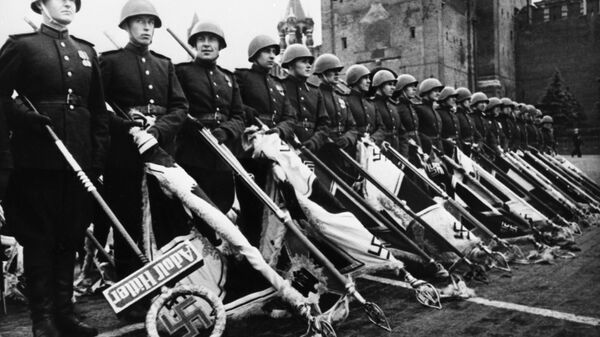The Most Symbolic
On May 9, 1965, on the 20th anniversary of victory and under the personal initiative of Soviet General Secretary Leonid Brezhnev, himself a war veteran, Moscow saw its first Victory Day parade in 20 years. The 1965 parade was the first to see the carrying of the Banner of Victory hoisted above the Reichstag on May 1, 1945. The same day, Moscow, Leningrad, Odessa, Sevastopol, Volgograd (Stalingrad), and Kiev all officially received the title of Hero City.
The Grandest
In another 20 years, on May 9, 1985, newly chosen Soviet leader Mikhail Gorbachev presided over the grandest Victory Day parade since 1945. The celebration had it all: veterans of the 1945 parade marching along Red Square's paving stones, partisans, workers of labor fronts, Polish and Czechoslovakian veterans, modern troops, some in historical costumes, and modern weapons systems.
The Most Unusual
In 1995, the 50th anniversary of victory was marked in an unconventional way. Roughly 5,000 veterans from all across the former Soviet Union marched through Red Square, where, for the first time, they were greeted by multiple foreign guests – US President Bill Clinton, British Prime Minister John Major, Canadian Prime Minister Jean Chretien, Chinese leader Jiang Zemin, UN Secretary General Boutros Boutros-Ghali, and others. Due to the construction of the Okhotny Ryad shopping center on Manezh Square, the heavy equipment and airborne component of the parade was moved to Poklonnaya Hill, where the Great Patriotic War museum, whose construction began in 1987, was finally opened. The parade took place at a very difficult time in Russia's history, following the catastrophic collapse of its economy, defeat in the war in Chechnya, and the disintegration of Soviet-era alliances across the globe. On a positive note, it was this year that the Victory Day parade became an annual tradition.
The Most United
The May 9, 2010 parade, marking the 65th anniversary of victory, was the first time that servicemen from the countries of the Western anti-Hitler coalition took part in a Russian Victory Day parade. Troops from the US, the UK, and France, as well as Poland (whose troops took part in the 1985 parade), participated in the memorable ceremony, with battalions from Armenia, Azerbaijan, Belarus, Kazakhstan, Kyrgyzstan, Moldova, Tajikistan, Turkmenistan and Ukraine also taking part. President Dmitry Medvedev said the inclusion of the foreign troops was a recognition of the shared Allied victory in WWII. The celebration was not without controversy, however, with protests led by the Communist Party complaining about the decision to allow NATO troops to march across Red Square.
The Most High-Tech
The 2015 Victory Day parade is remembered as one of the grandest in scope (seeing the participation of over 16,000 servicemen and women), and perhaps the most high-tech, showing off for the first time a new generation of Russian military equipment, including the T-14 main battle tank, the T-15 and Kurganetz-25 infantry fighting vehicles, the Bumerang armored personnel carrier, the 2S35 Koalitsiya-SV self-propelled howitzer, the Ural Typhoon MRAP, the BTR-82AM naval infantry APC, the Kornet-D/EM mobile antitank missile system carried by GAZ Tigr light APCs, and the RS-24 Yars mobile ICBM launcher. Under President Vladimir Putin's initiative, the 2015 celebration was the first to be marked by a moment of silence for the fallen. Defense Minister Sergei Shoigu also famously made the sign of the cross before the start of the parade, prompting commotion in Russian and foreign media.
Bonus: The Original
Commemorative parades are all well and good, but nothing beats the original Victory Day parade, marked on June 24, 1945. The ceremony was the largest ever held, featuring some 40,000 troops and 1,850 pieces of military hardware. Marshals Georgy Zhukov and Konstantin Rokossovsky rode through Red Square on white and black stallions. Soviet leader Josef Stalin, soldiers, officers and foreign dignitaries presided over the parade from atop Lenin's Mausoleum. The parade included the famous moment when Red Army troops threw Nazi banners down before the Mausoleum, including the banner of the 1st SS Division Leibstandarte SS Adolf Hitler, Hitler's personal bodyguard unit.


